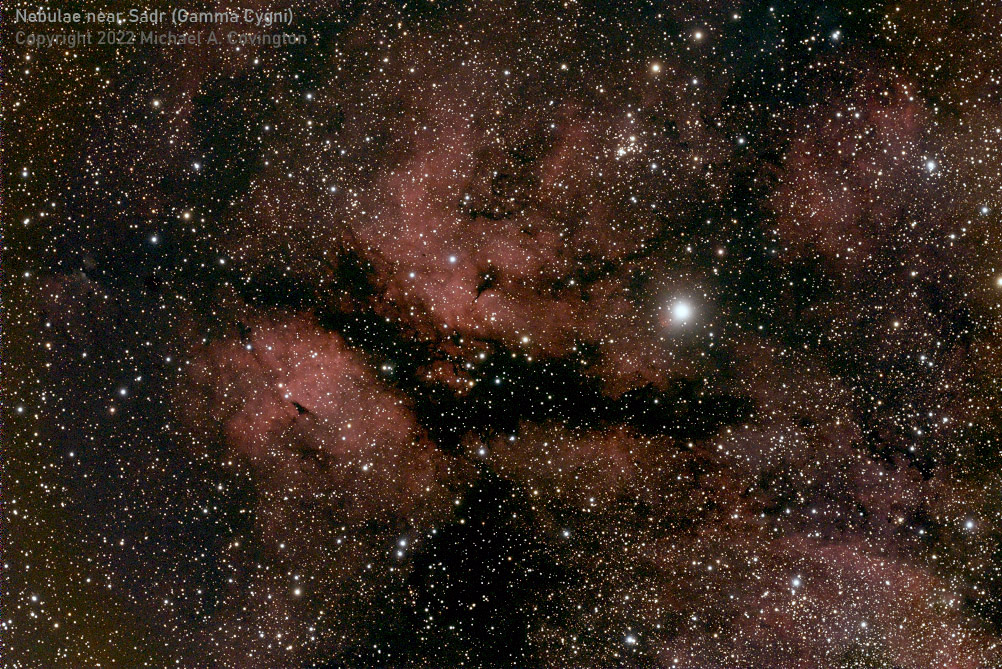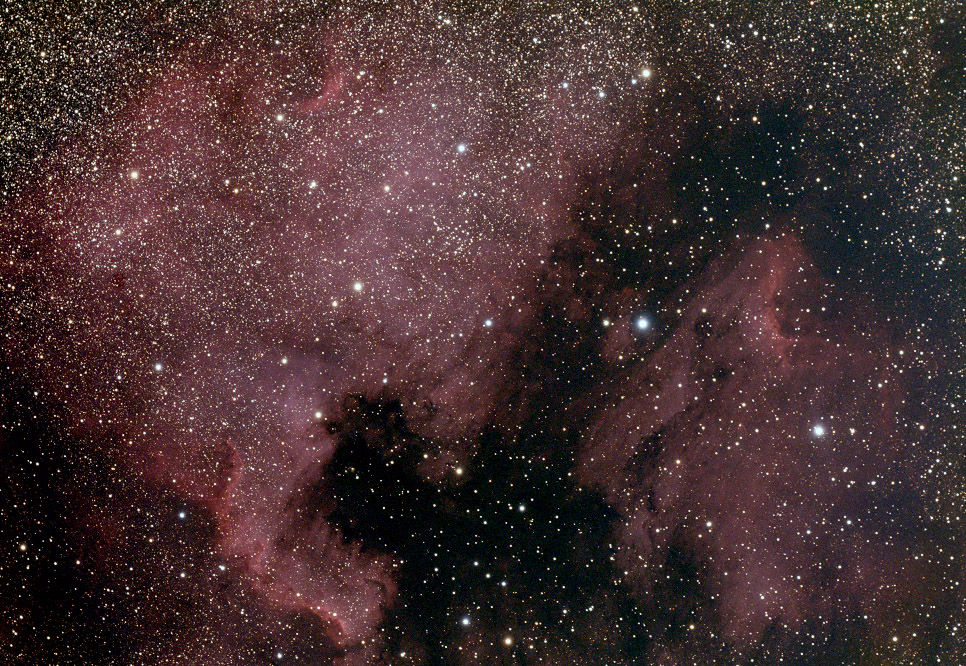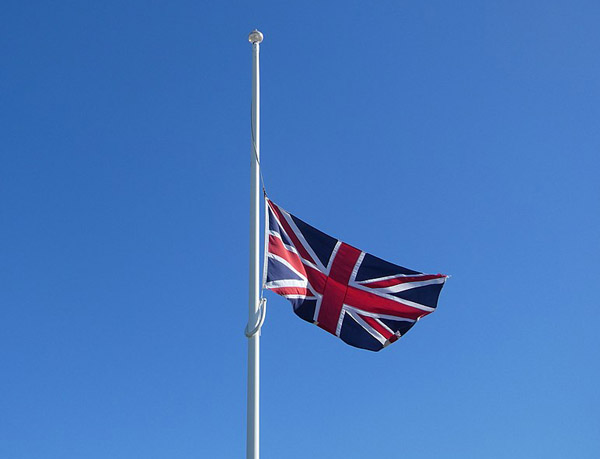| |
The constellation Cygnus is in the direction of a major spiral arm of our galaxy,
and there's a lot of everything in it — especially stars and dust clouds.
Here you see the star Gamma Cygni (Sadr), some red emission nebulae, some black lanes
of dust, and a few star clusters.
This happens to be the first part of the sky I ever looked at with astronomical interest —
in October 1967, using my grandfather's 7×35 binoculars at his home out in the country,
and seeing, of course, only clouds of stars, not nebulae.
Stack of 40 2-minute exposures, AT65EDQ refractor (6.5-cm f/6.5), Nikon D5500 (H-alpha modified), GM811G mount,
and tiny iOptron iGuider guidescope and camera.
Permanent link to this entry
North America and Pelican Nebulae
|
2022
September
23
|
Back on campus
Yesterday I gave a talk to a class at the University of Georgia and spent the rest of the day
on campus, doing some work in the library with a laptop.
Today I decided to do more of the same. It was good to be back in a familiar environment.
That university is, in an important sense, my home.
There are things I need to catch up with. The whole environment is more comfortable
if not luxurious. Many buildings have been remodeled or at least have new furniture.
I enjoyed lunch at a bagel shop inside the Main Library. The bus system
has been revamped; the routes had changed little from my first encounter with them (1972)
until a major reorganization in 2019. Now the bulk of the traffic is carried in two loops
that go in opposite directions — a very sensible idea. The bus stops are farther apart, which is reasonable,
and some have been decommissioned. Unfortunately, the decommissioned ones are not necessary
marked as such; yesterday I was one of several who were tricked by the defunct Soule Hall
bus stop, which still has a shelter in good condition; today I figured it out.
The students are numerous and happy, though now they're almost as young as my grandchildren.
I've been accustomed to being around energetic young people my whole life; maybe it will
keep me young.
Permanent link to this entry


|
2022
September
22
|
Two views of the Crescent Nebula
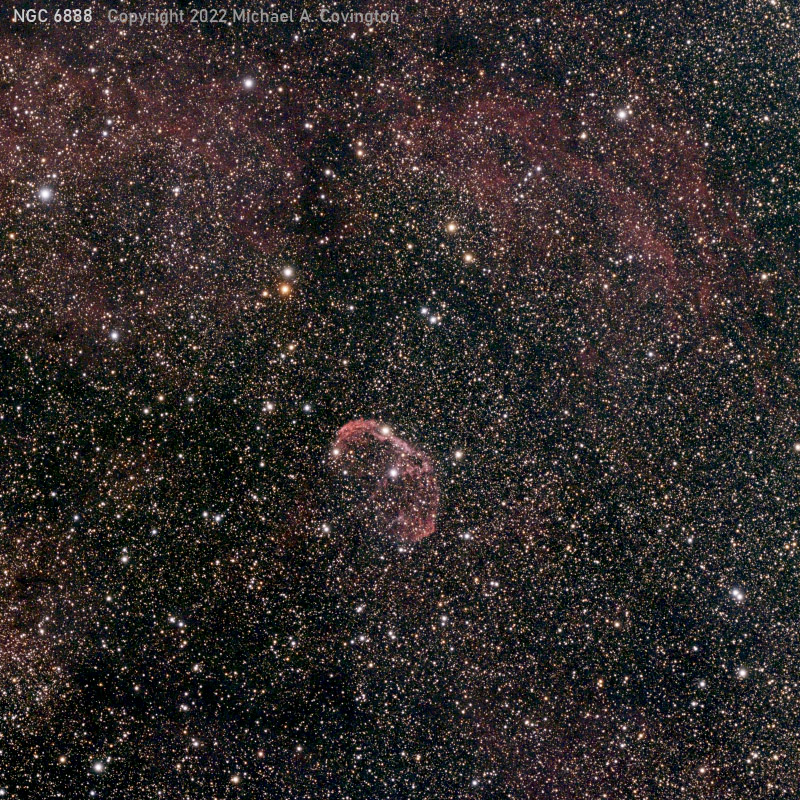
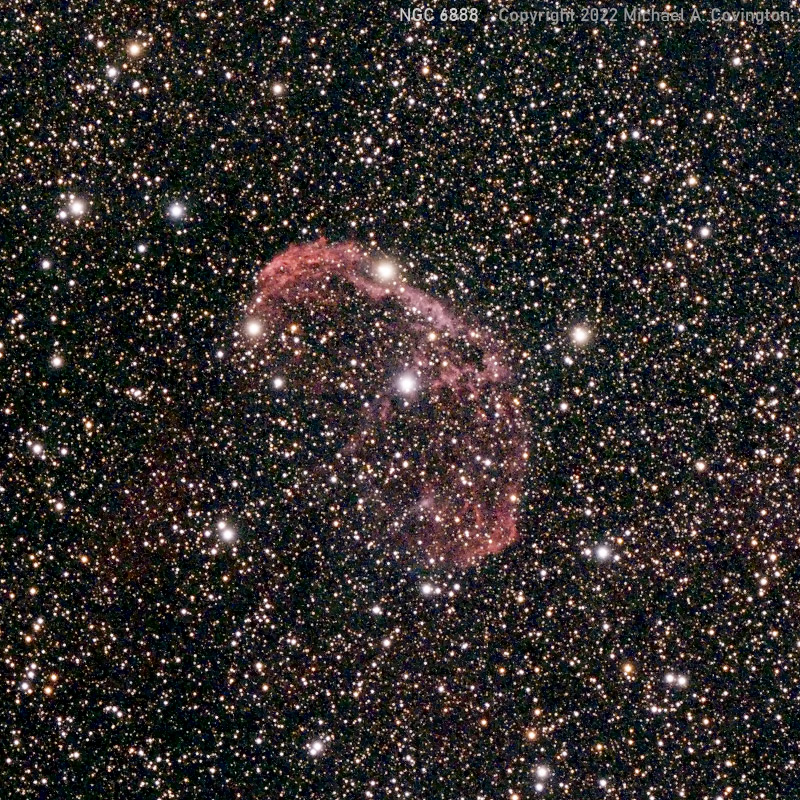
These are actually the same picture — the second one is just the center of the
picture magnified larger, or rather not reduced as much (these are both far from the full
resolution of my camera, and that's a good thing, because reducing them hides grain and
imperfections).
The object, NGC 6888, the Crescent Nebula, is a gassy shell thrown off by a star
(not a supernova). In the wider-field picture you can see some other red nebulosity,
and also a dark nebula (dust cloud) that winds through the picture like a river.
Stack of 37 2-minute exposures, AT65EDQ refractor (6.5-cm f/6.5), Nikon D5500 (H-alpha modified),
Losmandy GM811G, iOptron iGuider 30×120 guidescope and camera.
This was a satisfying session using equipment that was nowhere near its limits,
and hence very reliable, so that I got 39 out
of 40 perfectly guided images. The first of the 40 was not perfectly guided because the guider
hadn't settled down yet, and two others were marred by satellite images. I did almost all the
photography by remote control, sitting indoors at the breakfast table, using remote desktop mode
to connect to the laptop that was outside controlling the telescope and camera.
That will be a handy thing to do on cold winter nights!
Permanent link to this entry


|
2022
September
20
|
NGC 6823 and 6820
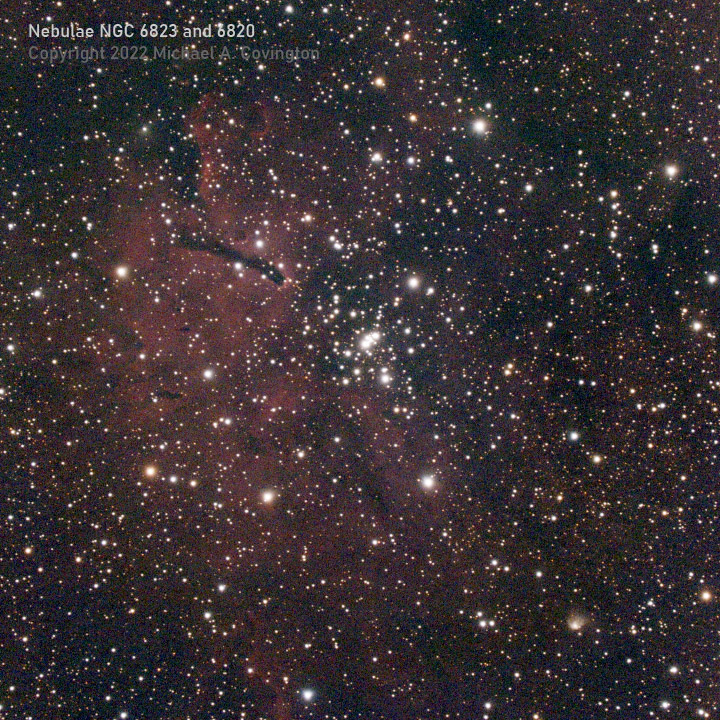
On to new horizons! I got tired of "teaching new dogs old tricks"
(replicating earlier results with new equipment) and wanted
to photograph something I hadn't photographed many times before.
(I first thought mistakenly I had not photographed these objects at all,
but in fact I paid them a visit in August 2021.) So here are NGC 6823 (a star
cluster with a lot of red hydrogen gas) and NGC 6820 (a compact dust cloud around
a star at the lower right, making it look lopsided, like a comet).
This is the main product of last night's observing session. It's a stack of
forty 2-minute exposures with the Celestron 8 EdgeHD, f/7 reducer, Nikon D5500
(H-alpha modified) at ISO 200, guidescope, and Losmandy GM811G mount.
Permanent link to this entry
M14 (Messier 14)
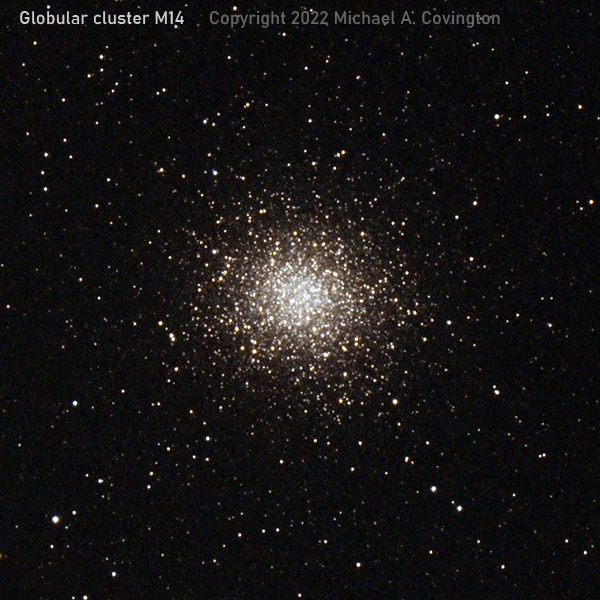
I wanted to have something to do
while NGC 6823 was getting into position, so I took ten 2-minute exposures of M14
and stacked nine of them (one came out the wrong length due to a software problem).
One thing I like about digital images of
globular clusters is that, unlike what would happen in a film image, the center of the
cluster is not burned out. You can see stars all the way to the middle, just as when
viewing the cluster with a telescope.
Permanent link to this entry
Deconvolution works
Although my mount performed beautifully, neither of the two pictures above was quite
perfectly guided because of some kind of differential flexure (something causing the
main telescope image to shift relative to the guidescope). It was probably mirror shift
in the C8 EdgeHD (despite its mirror locks). In the long run I'll track it down, but
in processing these pictures I used motion-blur deconvolution in PixInsight.
How far we've come! In the 1990s I wrote about deconvolution, but it was slow to compute
and worked poorly. Both the algorithm and the computer hardware have come a long way since then.
The basic idea is that if a picture is smeared by motion or poor tracking, and you can
describe the smear precisely, the computer can undo it. Slight tracking flaws in astrophotos are
one of the simplest possible cases of this. The Richardson-Lucy maximum-entropy algorithm
undoes the blur. "Maximum-entropy" means it seeks the simplest image that could have been
the input to the smearing process; that's important; it won't hypothesize that I've
lost fine detail that was actually never there.
Two hints for users of motion-blur deconvolution:
(1) Use it only when the amount of smear (in this case, elongation of star images) is very small;
(2) Do it by trial and error, and do slightly less than you think you need. Try to undo
maybe 80% or 90% of the smear. If you go over 100% you'll get very strange black marks
flanking all the stars.
Permanent link to this entry


|
2022
September
19
|
Veil Nebula
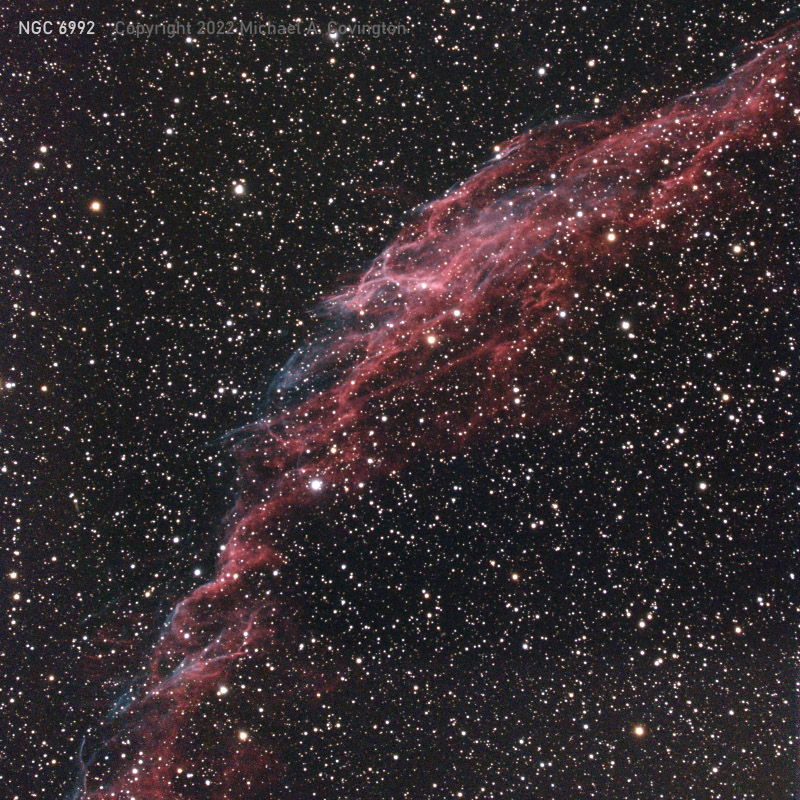
Clear weather has been so scarce that it has taken me this long to get a really good picture
with the aid of my new Losmandy mount — an official "first light" picture, so to speak.
(I am not exactly sure why "first light" is the cliché for inaugurating an observatory, but it is.)
This is the eastern part of the Veil Nebula, a large ring of gas that is the remnant of an
ancient supernova. It is barely visible with a good telescope, but the camera accumulates light
and brings out not only its intricate shape but also its colors.
Stack of 41 2-minute exposures, Nikon D5500 (H-alpha modified) at ISO 200, Celestron 8 EdgeHD
(200 mm aperture) with f/7 compressor giving 1400 mm focal length; 60×240-mm guidescope,
ASI120MM-S guide camera, PHD2 guiding software, BackyardNikon imaging software.
Caeli enarrant gloriam Dei.
Permanent link to this entry


|
2022
September
17
|
A hopeful development for Sharon
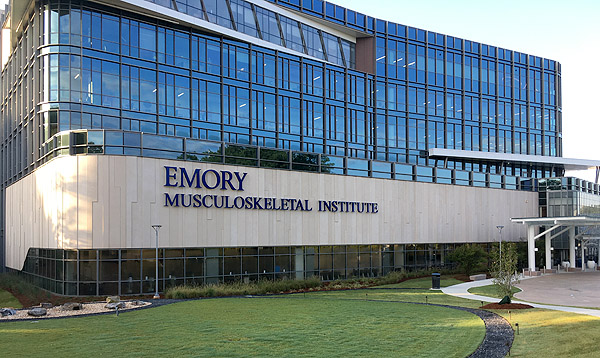
Yesterday (Sept. 16), Sharon had an operation that will apparently give her considerable
relief from her chronic pain — a pectoralis minor release, performed by Dr. Eric Wagner
at Emory. This consists of disconnecting a small muscle that was chronically in severe spasm,
so it no longer has anything to pull against. This does not produce any noticeable impairment unless you're
something like a baseball pitcher (in her case left-handed), since the small loss of strength
is easily compensated by building other muscles. Botox shots into this muscle have previously
provided temporary relief; this will be permanent, although a couple of years of intensive
physical therapy are needed.
It was a wild day; to arrive by 6 a.m., we had to get up at 3:15 a.m. and drive into Atlanta
from Athens. Fortunately, we made good time (no traffic!) and had a great choice of parking spaces
at 5:30 a.m. It was an arthroscopic outpatient procedure, and by 1 p.m. we were back at home in Athens.
That was the easy part. Previously, on Monday, Wednesday, and Thursday afternoons, Melody and I had spent
hours in negotiations with Anthem (Blue Cross). When I went on Medicare at the beginning of the month,
Melody and Sharon continued to be insured under my UGA retirement plan, but the transition wasn't
smooth. Melody was issued a new Anthem card with a new number on it, although it may not
have been properly activated. Sharon was just dropped.
There ensued negotiations between University System of Georgia Benefits, which insisted that it was
paying for Sharon's insurance and had included her on at least two (later three) data files
naming the insured people; and Anthem, which had somehow left her out.
Many phone calls were made, and I will give Anthem credit for better-than average music-on-hold;
we heard Chuck Mangione's "Feels So Good" so many times that we will probably always
associate it with this episode.
I decided we would go ahead and have the surgery and bring a lawsuit if necessary
(complaints to insurance regulators would probably have sufficed).
Eventually, though, late on
Thursday afternoon, a helpful representative at Anthem (who had put about 6 hours into this!) came through with
Sharon's new ID number and verbal assurance that she is insured. The next morning, she showed up
as insured on Anthem's customer web site, though it will not yet display a complete ID card, only
a tentative one indicating the numbers. I think they are still afraid of a lawsuit or regulatory action,
and rightly so. We don't know how many other people they lost!
That was actually the most agonizing part of the whole thing. Getting up at 3:15 was easy by comparison.
And we are glad to have Sharon home and feeling better than before the operation
(though we know the pain will worsen again during recovery, and there's a long road ahead).
We thank all who offered their prayers and moral support.
Permanent link to this entry
65 and still alive
Wednesday (Sept. 14) was my 65th birthday; I've reached what was the average age of death of workers
at the time Social Security was instituted. Of course, nowadays it's common to live a lot longer,
and that's what I aim to do!
Although my pension plan required me to start Medicare, I am not yet collecting Social Security;
I'll hold out longer for more money, or at least until I'm
in a lower tax bracket.
But although I'm no expert on Social Security, I do want to point out a couple of things.
There has always been unclarity about whether Social Security is a private retirement account you
pay into (as it claims to be) or a Ponzi scheme that relies on payments from new members (workers),
who are more numerous, to pay for the benefits paid to
older members (retirees). A justification for the latter, I think a good one, is that it is a
"pact between the generations" (as Mankiw or somebody called it): We pay higher taxes, but we don't have
to take Grandma into our home when she gets old, and she's not at risk if something happens to us.
Also, Social Security pays supplemental income
(not based on money paid in) to retirees with low incomes, and to the disabled.
This is a good thing to do, but we shouldn't misrepresent how we're doing it.
There is also controversy about the Social Security trust fund, which is invested in treasury bonds,
i.e., lent to the U.S. Treasury (that's what a bond is). Essentially, it's money lent by the
government to itself, and exists only on paper, as an accounting measurement
(in fact a useful one). It's not invested in
anything of external value (real estate, corporations, loans outside the government, or
even money deposited in commercial banks).
That is not as stupid as it sounds, because during the Great Depression, everyone was aware that
all those investments could lose their value dramatically, and the government's promise to
make the payments was the only thing they wanted to rely on.
Because we're living longer and the population isn't growing, Social Security is having funding
problems. I think the obvious solution is to raise the retirement age appreciably.
We're no longer washed up and unable to work at 65; nor should people feel entitled to be idle
just because they've reached that age, regardless of health. I'm doing my most important
work now. I'm nowhere near ready to stop and be bored.
I would also look favorably on some kind of compulsory IRA as an alternative to Social Security —
with a couple of cautions. IRAs, suitably invested, can yield a lot more return
than Social Security payments. But they can also be wiped out in an economic depression,
and that's why Social Security isn't invested that way. Maybe those ideas are 80 years out of date;
maybe they aren't. But they deserve some consideration. So does the question of how to protect
low-income retirees and the disabled.
Permanent link to this entry
Weather playing cat-and-mouse with me
On the 14th and 16th, I got my telescope out, only to have the sky cloud up
(with clouds almost invisible satellite pictures) before it got completely dark.
Tonight I've set everything up again; will it happen again?
At least I've gotten practice setting up the GM811G.
These briefly-clear nights are not as frustrating as the long series of cloudy nights
that we've been having for weeks.
Permanent link to this entry


|
2022
September
13
|
Inflation, misunderstood
I'm seeing a lot of confused and misleading reporting of inflation.
If I have the numbers right, the seasonally adjusted CPI is up 0.1% since last month. If it rose at that rate for a whole year, it would rise 1.2% a year.
Prices are 8.3% higher than they were a year ago. People are reporting this as the "annual inflation rate" but it does not mean prices are continuing to rise 8.3% per year. It means they did rise in recent months and haven't come back down. They have roughly leveled off. If you're against inflation, that's what you want, I think.
We may not want prices to drop drastically and suddenly. That is devastating for retailers, whose income comes entirely from markup; employees who don't want deflationary pay cuts; and other people who have made other plans based on no deflation. Instead, what I think we want, mainly, is for incomes to catch up. That's what normally happens gradually when inflation levels off.
You can have your own opinion about that; but the main thing is, prices are not rising 8.3% per year now.
[Also posted on Facebook and LinkedIn.]
[Added:] Here's a simpler example. Suppose the cost of living, measured in some reasonable way,
is 100 in the first month, 110 in the second month, and 111 in the third month.
Then in the third month, prices have again gone up up but inflation has gone markedly down
(the rate of rise has gone down). It's like the difference between hitting the brakes
and putting the car into reverse. Clear now?
Permanent link to this entry


|
2022
September
9
|
COVID today
This past Wednesday was the first time since Georgia started releasing COVID statistics
that I forgot to look at the update as soon as it came out.
COVID continues to decline. Here are the graphs, starting in March 2020.
(A defect in the graph in April 2022 due to a reporting problem has been cut out.)
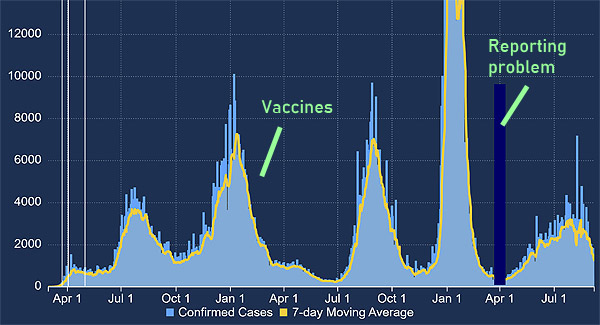
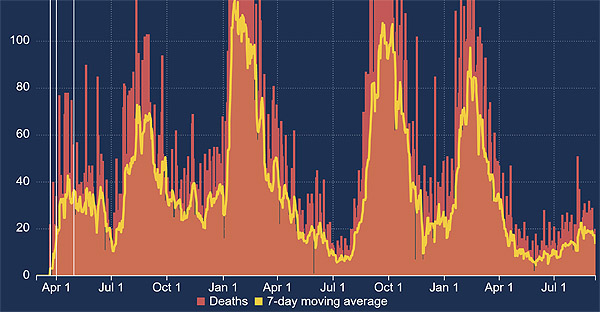
Now, look at the cycles. There's a wave every January and every July.
The death rate was much lower in the latest wave than before;
it appears that milder cases are starting to predominate.
Quite a few of us have probably had mild COVID (even more than once)
without knowing it.
I've had 3 vaccine doses, and a fourth one is in the works; like flu vaccines,
these are probably going to be given annually, each one adjusted to protect against
the latest strains.
COVID precautions in public are now minimal. You'll see a few people wearing masks
in big stores, and many in doctors' offices, but very few places require them.
We stand farther apart in line, thank goodness; I hope a tradition of
less crowding and better cleanliness persists.
Permanent link to this entry
Short notes
Google has finally made its peace with the new URL for my web site, and there are no
serious gaps in coverage. Apparently it didn't like either HTTP itself, or the
transition from HTTP to HTTPs. That's over now. But Bing has been giving me better
coverage all along.
Stand by for a major announcement as the most important piece of technology that
I ever worked on starts to be publicized.
Permanent link to this entry


|
2022
September
5
|
Heart-feast for Stephen

Photo by Catherine Barrett
September 2 was an important anniversary for my youngest grandson, Stephen Barrett,
who was then 1 year and 2 days old. It was the anniversary of his heart surgery to
correct transposition of the great arteries. Without it he would have lived only a
few more days. With it, he is strong and robust. Here he's eating a commemorative
heart-shaped cookie.
Permanent link to this entry


|
2022
September
2
|
Search engines and the problem of canonicality
"Duplicate without user-selected canonical"
Both Google and Bing are covering the Daily Notebook much better now than they used to be.
Interestingly, if I take care of the things Google complains about, Bing also gives better
coverage without being prodded. I use the
Google URL Inspection Tool to find out what needs attention.
There is a similar tool for Bing.
My assumption was that I shouldn't need such things.
It's the search engines' job to find me, not the other way around.
Crucially, I'm not trying to be at the top of the search page.
I just care whether my stuff can be found at all. I started the Daily Notebook
so I could use search engines to find my own notes about a huge variety of topics
(and, often, share those notes with other people).
So I thought I had no need for the numerous things that go by the name of
search-engine optimization (SEO).
But neither Google nor Bing was indexing my recent pages. Here's an example of
a query that wouldn't work until just yesterday:
anosmia site:covingtoninnovations.com
Try it; it should work now. It means "find the word anosmia on the
site covingtoninnovations.com." It should land on the May 2022 page.
The problem was canonicality.
When a web page can be reached more than one way, the search engines have to
deduce what its canonical URL is — its best, most permanent address,
at which it should be indexed.
I was redirecting www.covingtoninnovations.com/michael/blog to the latest
Daily Notebook entry, and changing the redirection every month.
I labeled it as a type 302 (temporary) redirection.
The trouble is, when a search engine reaches something through a 302 redirection,
it assumes the page on which it has landed is not canonical and should not
be indexed. So Google and Bing were seeing the Daily Notebook frequently
but not indexing it.
I changed the redirection to type 301 (permanent), which does signal that the
destination is canonical, and coverage got a lot better.
But that's not all. The current expectation is that if a web page can be reached
more than one way, it should preferably declare its own canonical address
with a directive like this (in the <head> section, not the <body>):
<link rel="canonical" href="https://www.covingtoninnovations.com/michael/blog/2209/index.html">
I am adding these to newly created pages that can be reached by redirection.
I am also using Google's tool to find out what existing pages may have problems that
this could help with ("Duplicate without user-selected canonical").
Why did all this happen? I am assuming (but don't actually know)
that some people were trying to game the system, to trick Google into giving them
a higher ranking, by making large numbers of redirection links to the same page.
Permanent link to this entry


|
2022
September
1
|
"Black hole" is in bad taste; we need a new term
In this video,
Becky Smethurst points out,
and other sources confirm,
that the astrophysical term "black hole" originated as the
physicist Robert Dicke's deliberate allusion to the
Black Hole of Calcutta, a cruel prison cell into which people
were packed so densely that they died.
Even if you don't know that, the term is misleading, because black
holes aren't "holes" in spacetime. Objects falling into them do not
disappear. They just get trapped and compressed into a very dense state.
Nor do they suck objects into them like whirlpools or vacuum cleaners.
Space isn't filled with water or air flowing into the black hole and
carrying things with it. Black holes pull objects in only by means of
gravity, which works the same way as with any other object of the same mass.
Black holes are normally surrounded by empty space and can be in stable
orbits with other objects.
Even "black" is potentially misleading. To be sure, no light comes out
of the black hole itself, but the matter on the verge of falling into it
is certainly luminous.
We need a new term. I'm not too fond of Dr. Smethurst's proposal, dark star,
because it could also mean a star that has gone dark without undergoing
gravitational collapse. Gravity trap was the first one that occurred
to me; collapsar has its advocates. I hope the astronomical community
will settle on something better than "black hole."
Permanent link to this entry


|
|
|
This is a private web page,
not hosted or sponsored by the University of Georgia.
Copyright 2022 Michael A. Covington.
Caching by search engines is permitted.
To go to the latest entry every day, bookmark
https://www.covingtoninnovations.com/michael/blog/Default.asp
and if you get the previous month, tell your browser to refresh.
Portrait at top of page by Sharon Covington.
This web site has never collected personal information
and is not affected by GDPR.
Google Ads may use cookies to manage the rotation of ads,
but those cookies are not made available to Covington Innovations.
No personal information is collected or stored by Covington Innovations, and never has been.
This web site is based and served entirely in the United States.
In compliance with U.S. FTC guidelines,
I am glad to point out that unless explicitly
indicated, I do not receive substantial payments, free merchandise, or other remuneration
for reviewing or mentioning products on this web site.
Any remuneration valued at more than about $10 will always be mentioned here,
and in any case my writing about products and dealers is always truthful.
Reviewed
products are usually things I purchased for my own use, or occasionally items
lent to me briefly by manufacturers and described as such.
I am no longer an Amazon Associate, and links to Amazon
no longer pay me a commission for purchases,
even if they still have my code in them.
|
|




